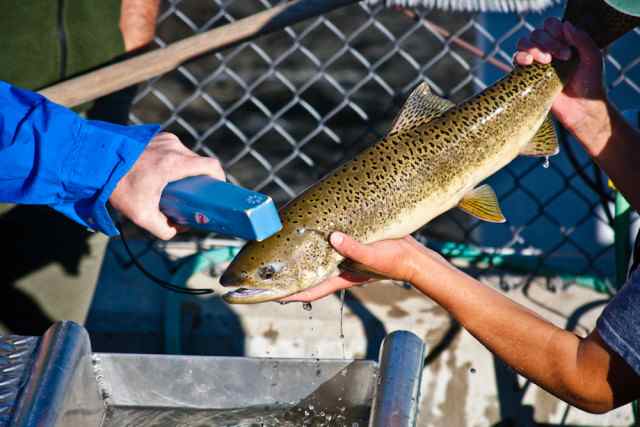forum
library
tutorial
contact

Study Says Hatchery Fish are
Boosting Idaho Chinook Run
Bill RudolphNW Fishletter, October 19, 2012
|
the film forum library tutorial contact |

|
Study Says Hatchery Fish are
Bill Rudolph |
 Results of a study by several Northwest fish biologists, published in the peer-reviewed journal Molecular Ecology, show that hatchery fish have helped to boost overall fish runs when they were allowed to spawn with a wild summer chinook population in Idaho's Johnson Creek, a tributary of the South Fork of the Salmon River.
Results of a study by several Northwest fish biologists, published in the peer-reviewed journal Molecular Ecology, show that hatchery fish have helped to boost overall fish runs when they were allowed to spawn with a wild summer chinook population in Idaho's Johnson Creek, a tributary of the South Fork of the Salmon River.
The BPA-funded study--part of a supplementation effort under way since 1998--has been making headlines because its findings run counter to earlier results derived from intense scrutiny of steelhead returns in Oregon's Hood River. Researchers from Oregon State University found that overall fish fitness declined significantly when hatchery-origin fish spawned with natural-origin Hood River steelhead.
The paper, titled "Supportive breeding boosts natural population abundance with minimal negative impacts on fitness of a wild population of Chinook salmon," was written by lead author Maureen Hess, a geneticist with the Columbia River Inter-Tribal Fish Commission, and biologists from the Nez Perce Tribe. Using DNA analysis, they found that after seven brood years, fish removed from the creek's weir to serve as hatchery broodstock produced 4.69 times more returning adult offspring and 1.32 times as many returning grand-offspring than naturally spawning chinook in Johnson Creek.
The researchers said their results showed that reproductive success of successful hatchery-reared parents was not significantly different from wild parents, and that mating types (H x H, H x W, or H x -- [unknown]) weren't significantly different from mating by wild-origin parents (W x W; or W x --). "Thus, evidence does not support that Chinook salmon reared for a single generation in the hatchery had negative fitness effects on wild-origin-fish in Johnson Creek."
The study did note the hatchery produced far more jacks (precocious males that return a year early) than the wild population. Returns from brood year 2000 were more than 40-percent jacks, while the wild component contained only 13 percent. But the researchers said there was no evidence of a shift in age at return over time. They said the effects of hatchery jacks on the long-term viability of the natural population would be evaluated in the future.
The authors speculated in their "discussion" section that the significant reduced fitness of hatchery-produced males "may be attributable to the artificial mating of competitively less-fit males (e.g. less aggressive) that may not have otherwise successfully reproduced in the wild."
The authors also said the differing results compared to other studies that found reduced fitness in some supplemented populations may be due to the comparative lack of hatchery influence in Johnson Creek compared to the upper mainstem of the South Fork of the Salmon River. They also noted that the Johnson Creek enhancement used only natural-origin broodstock.
The study also said that since the focus of many previous hatchery/wild studies was on steelhead, maybe these fish "are simply more prone to reduced fitness due to hatchery rearing practices." Steelhead in hatcheries are raised to smolt size in a single year, while in natural surroundings, they generally take two years to mature to that level. The juvenile chinook spend a year in hatcheries to reach the smolt-stage as well, but it more closely reflects growth in a natural state.
The authors said even though wild-origin fish are used in the Johnson Creek project, small changes in genetic fitness from hatchery rearing could show up in future returns. They therefore plan to evaluate Johnson Creek chinook runs beyond the two generations examined in this study.
The Johnson Creek enhancement project was started by the Nez Perce Tribe in 1998, to boost a run that had dropped to five pairs of spawners in 1995. According to the tribe, adult return numbers are now consistently meeting the short-term abundance goal of 350 returning adults, with more than 1,000 adults returning in some years.
learn more on topics covered in the film
see the video
read the script
learn the songs
discussion forum
